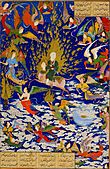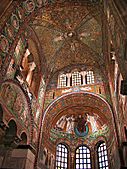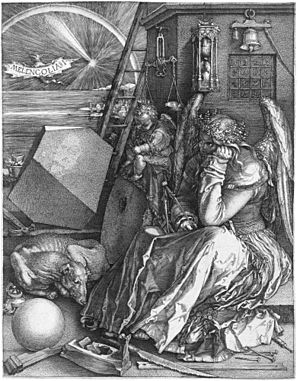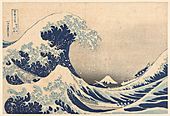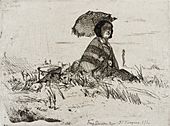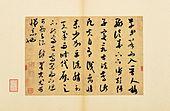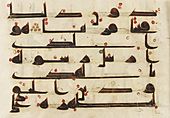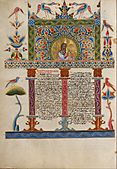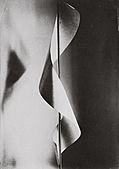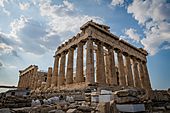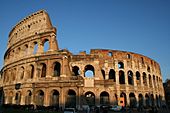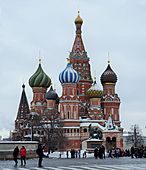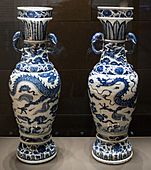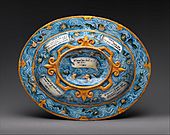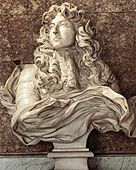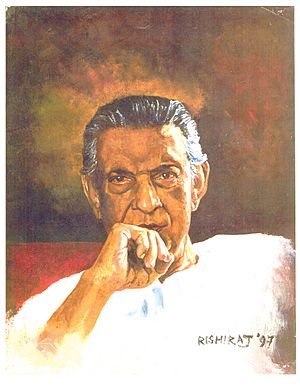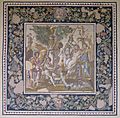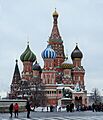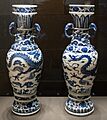Fine art facts for kids



Fine art is a type of art made mainly for its beauty and to show an artist's creativity. It's different from decorative art or applied art, which also have a practical use, like pottery or metalwork. In the Italian Renaissance, people thought the best art showed the artist's imagination freely, without needing to be useful. It was also important that one artist could create the whole piece, not many people with different skills. Even within fine arts, some types were seen as "higher" than others, like history painting over still life.
Historically, the five main fine arts were painting, sculpture, architecture, music, and poetry. Performing arts like theatre and dance were also included. Today, when we talk about fine art, we usually mean visual arts. This includes old master prints and drawings, which are like painting. Modern fine arts can also include film, photography, and video production.
One way to define fine art is "a visual art made mostly for its beauty and ideas, judged by how beautiful and meaningful it is." This includes painting, sculpture, drawing, watercolor, graphics, and architecture. People believed that appreciating fine art required good taste, which set it apart from popular art or entertainment.
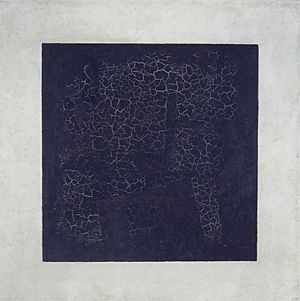
The word "fine" in "fine art" doesn't mean the art is necessarily better quality. Instead, it refers to the "purity" of the art form, meaning it's not mixed with practical uses. This idea came from traditional Western European thinking. It usually left out "useful" arts like crafts or decorative arts. However, today, these differences are less important. What the artist intends or the idea behind the art is often seen as most important, no matter how it's made.
The term "fine art" is mostly used for Western art from the Renaissance onwards. But other cultures, especially in East Asia, had similar ways of separating art forms. Sometimes, "fine arts" are called "major arts," and "minor arts" are the decorative arts. This was common for art from the Middle Ages and ancient times.
Contents
How Fine Art Began and Developed
Some experts believe the idea of "fine art" as a special category started in the West during the early modern period. Larry Shiner, in his book The Invention of Art: A Cultural History (2003), says it began in the 18th century. Before then, "art" meant "skill," like in phrases such as "the art of war." An artist was a skilled maker, and a work of art was a useful product of that skill.
Other thinkers, like Paul Oskar Kristeller, also share similar ideas. However, some place the start of this idea earlier, in the Italian Renaissance. For example, Anthony Blunt noted that the term arti di disegno (arts of design), a similar idea, appeared in Italy in the mid-16th century.
Even in the classical world, where few writings on art survive, people likely made similar distinctions. The famous artists from that time were mostly Greek painters and sculptors. They were admired and copied for centuries. The idea of an individual artistic genius, important in the Renaissance, came from classical examples, especially those written about by Pliny the Elder.
The idea of "fine art" started to become less popular around 1880. By 1900, folk art was also seen as important. By 1920, experts in art theory began to move away from the term "fine art." This was because people interested in industrial design argued against having different standards for art and useful objects. However, it took much longer for art dealers and the public to change their views. In fact, during this time, prices for fine art works grew much faster than for decorative arts.
In the art trade, the term "fine art" is still used for objects made before about 1900. It helps define what certain auctions or departments in auction houses handle. The term is also still used in tertiary education (college and university). You can find it in the names of colleges, departments, and courses, especially in North America and other European countries.
Art Around the World

The idea of separating fine arts from decorative arts or crafts, common in Europe and the US, isn't found in all cultures. But traditional Chinese art had similar differences. For example, Chinese painting distinguished between literati painting (landscapes by educated people) and the work of court painters and sculptors. While things like ceramics and jade carving were highly valued, the artists who made them often remained unknown, even more so than in the West.
Similar distinctions were made in Japanese and Korean art. In Islamic art, calligraphy and the painters of Persian miniatures were highly respected. These artists often worked for the court. They also designed patterns for the best Persian carpets and architectural tiling, more often than artists in the West did.
Latin American art was greatly influenced by European styles until the 20th century. Then, local art began to become more important, inspired by the Constructivist Movement. This movement brought arts and crafts together based on socialist ideas. In Africa, Yoruba art often has political and spiritual meanings. Like Chinese art, Yoruba art often includes things that Westerners might call crafts, such as textiles.
Visual Arts
Two-Dimensional Works
Painting and Drawing
Painting as a fine art means putting paint on a flat surface. This is different from painting a sculpture or pottery. Early paintings were on natural rock or walls, using techniques like fresco. For centuries, portable paintings on wood panels or canvas have been important in the Western world, often using tempera or oil painting. Asian painting often uses paper, with ink and wash painting being popular in East Asia. Small paintings for books are called "miniatures." Watercolour is a Western way of painting on paper. Other forms using gouache, chalk, or similar materials without brushes are usually considered types of drawing.
Drawing is a major visual art form, and painters need good drawing skills. Common tools include graphite pencils, pen and ink, inked brushes, crayons, charcoals, chalk, pastels, and markers. Drawing has many styles, including cartooning and creating comics.
-
A Persian miniature showing the Mi'raj (journey) of the Prophet, by Sultan Mohammed, 1539–1543. It's in the British Library.
-
The Swing by Jean-Honoré Fragonard, 1767–1768. This oil painting is in the Wallace Collection.
Mosaics
Mosaics are pictures made from small pieces of stone or glass called tesserae. They can be for decoration or have a purpose. An artist who designs and makes mosaics is called a mosaicist. Ancient Greeks and Romans made very realistic mosaics. Scenes from myths or hunting were popular as the main part of a larger design. Early Christian churches from the 4th century onwards were decorated with wall and ceiling mosaics. Famous Byzantine churches with mosaics include the Basilica of San Vitale in Ravenna (Italy) and Hagia Sophia in Istanbul (Turkey).
-
Judgment of Paris mosaic from 115–150 AD, found in Antioch-on-the-Orontes.
-
The apse of the Santa Maria Maggiore church in Rome, decorated with this beautiful mosaic in the 5th century.
-
The inside of the Basilica of San Vitale in Ravenna (Italy), known for its detailed mosaics.
Printmaking
Printmaking is about creating images on paper that can be copied many times using a printing process. It has been an important art form for centuries in both the West and East Asia. Important historical techniques include engraving, woodcut, and etching in the West. In East Asia, woodblock printing was key, with the Japanese ukiyo-e style being very famous. Later inventions like lithography and photography changed printmaking.
Except for monotyping, printmaking can produce many copies of the same artwork, called a print. Each print is seen as an original, not just a copy. This is because the print is designed from the start to be a print, not just a copy of a painting. A single print is also called an impression. Prints are made from an original surface, called a matrix. Common matrices include metal plates (for engraving or etching), stone (for lithography), wood blocks (for woodcuts), and fabric (for screen-printing). Many nearly identical prints can be called an edition. Today, each print is often signed and numbered as a "limited edition."
-
The Great Wave off Kanagawa, a color woodblock print from 1829–1833.
-
En plein soleil, an etching by James Abbott McNeill Whistler, 1858.
-
Divan Japonais by Henri de Toulouse-Lautrec, 1893–1894. This is a lithograph.
Calligraphy
Calligraphy is a type of visual art. It's defined as "the art of giving form to signs in an expressive, harmonious and skillful manner." Modern calligraphy can be useful, like hand-lettered designs, or it can be fine art where the abstract look of the writing is more important than how easy it is to read. Classical calligraphy is different from printed text. It's historically disciplined but also fluid and spontaneous, created at the moment of writing.
-
Folio 27r from the Lindisfarne Gospels, 8th century. It's in the British Library in London.
-
On Calligraphy by Mi Fu, from the Song Dynasty in China.
-
Islamic calligraphy: A page from a Koran (8–9th century) with Abbasid Kufic Calligraphy.
-
A page from an Armenian illuminated manuscript, 1637–1638. It's at the Getty Center in Los Angeles.
Photography
Fine art photography means photographs made to show the artist's creative ideas. It's different from photojournalism, which tells stories, or commercial photography, which sells things. Fine art photography is mainly about the artist's vision, but it can also help promote certain causes.
-
Man Ray, Lampshade, published in 391, n. 13, July 1920.
-
An interior from Paris, taken by Eugène Atget around 1910.
-
The Tetons and the Snake River by Ansel Adams, 1942.
Three-Dimensional Works
Architecture
Architecture is often seen as a fine art, especially when its beautiful parts are highlighted. This is different from just the engineering or construction parts. Buildings are seen as cultural and political symbols and works of art. Many historical civilizations are known mainly through their amazing buildings. For example, the pyramids of Egypt and the Roman Colosseum are cultural symbols. Cities, regions, and cultures often identify themselves with their famous buildings.
-
The Parthenon in the Acropolis of Athens, dedicated to the goddess Athena.
-
The Colosseum in Rome.
-
Saint Basil's Cathedral in Red Square (Moscow).
Pottery
With some modern exceptions, pottery is usually not considered fine art. However, "fine pottery" is a real term, especially in archaeology. "Fine wares" are high-quality pottery, often painted or decorated. They are different from "coarse wares," which are basic pots used every day.
Even when a piece of pottery, like a porcelain figurine, has no practical use, it's often made by many people with different skills. This is why it's usually not seen as fine art.
-
An Ancient Greek volute krater from 320-310 BC. It's at the Walters Art Museum in Baltimore, US.
-
The David Vases from 1351 (Yuan dynasty). These porcelain vases are at the British Museum in London.
-
A Renaissance oval basin or dish from around 1559–1564. It's made of maiolica and is at the Metropolitan Museum of Art in New York City.
-
Rococo personifications of Classical elements, made in the 1760s by the Chelsea porcelain factory. It's at the Indianapolis Museum of Art.
Sculpture
Sculpture is three-dimensional artwork made by shaping hard or plastic materials. Common materials include stone (like rock or marble), metal, or wood. Some sculptures are made by carving. Others are put together, built up and fired, welded, molded, or cast. Because sculpture uses materials that can be shaped, it's considered one of the plastic arts. Much of the public art you see is sculpture. Many sculptures placed together in a garden are called a sculpture garden.
Sculptures made of stone last much longer than art made from materials that decay. So, stone sculptures often make up most of the art that survives from ancient cultures. However, most ancient sculptures were brightly painted, and this paint has usually been lost over time.
-
The Nefertiti Bust from 1352–1332 BC. This painted limestone bust is at the Neues Museum in Berlin, Germany.
Conceptual Art
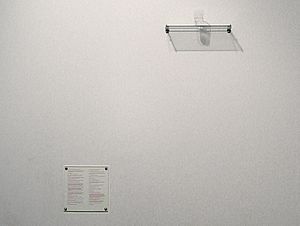
Conceptual art is art where the idea or concept behind the work is more important than how it looks or what it's made of. When the term started in the 1960s, it meant art based strictly on ideas, often presented as text. However, by the 1990s, especially in the UK, it became a common word for any contemporary art that doesn't use traditional painting or sculpture skills.
Performing Arts
Music
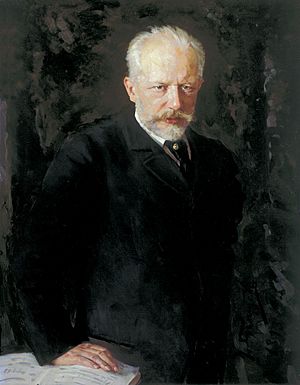
Music is an art form and cultural activity that uses sound organized over time. The main parts of music are pitch (for melody and harmony), rhythm (including tempo and meter), dynamics (how loud or soft it is), and the quality of the sound (like its "color"). Different styles of music might focus on some of these parts more than others.
Music is performed using many instruments and voices, from singing to rapping. There are pieces just for instruments, just for voices, and pieces that combine both. The word "music" comes from the Greek word mousike, meaning "art of the Muses."
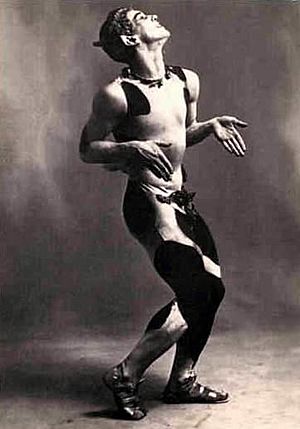
Dance
Dance is an art form that usually involves moving the body, often rhythmically and to music. It's used to show feelings, for social interaction, or as part of a spiritual or performance setting. Dance can also describe nonverbal communication between people or animals, like a bee dance. In sports, gymnastics, figure skating, and synchronized swimming are dance-like activities. The kata in martial arts are often compared to dances.
Theatre

Modern Western theatre often focuses on realism, including drama and comedy. Musical theatre is also very popular in the West. Older forms of theatre, like Greek and Roman drama, classic English drama (by Shakespeare and Marlowe), and French theater (by Molière), are still performed today. You can also sometimes see classic Eastern forms like Noh and Kabuki in the West.
Film
Fine arts film refers to movies and the field of film as a fine art form. A fine arts movie theater is a place where you can watch such movies. Films are made by recording images with cameras or by creating images using animation or special effects. Films are cultural artifacts that show and influence specific cultures. Film is seen as an important art form, a source of entertainment, and a powerful way to educate or influence people. The visual parts of cinema give movies a universal way to communicate. Some films become popular worldwide by using dubbing or subtitles to translate the dialogue.
Cinematography is the skill of choosing lighting and camera settings when recording images for movies. It's like still photography, but with the added challenge of both the camera and things in the scene moving.
Independent filmmaking often happens outside of big studio systems like Hollywood. An independent film (or indie film) is a movie made without money or distribution from a major movie studio. Creative, business, and technology reasons have all helped the indie film scene grow in recent times.
Poetry

Poetry comes from the Greek word poiesis, meaning "to make." It's a type of literature that uses the beauty and rhythm of language. It uses things like sound, how words feel, and meter to create meanings beyond the simple, everyday meaning.
Other Art Forms
- Avant-garde music is often seen as both a performing art and a fine art.
- Electronic media is one of the newest fine art forms. It uses modern technologies like computers for creating and showing art. This includes video, digital photography, digital printmaking, and interactive art.
- Textiles, like quilt art and "wearable" art, can often be considered fine art objects, sometimes as part of an art show.
- Western art (or Classical) music is a performing art often considered fine art.
- Origami – In the last century, there's been new interest in understanding how folding materials behave, with help from artists and scientists. Origami is different from other arts: painting adds material, and sculpture removes it, but origami transforms. Origami artists are pushing the limits of this art, which is connected to technology and even spacecraft. Its computer-like aspects and how easily it can be shared online make origami an important art form of the 21st century.
Studying Fine Art
In the United States, you can study fine art in college. You can earn a Bachelor of Arts in Fine Art, a Bachelor of Fine Arts, or a Master of Fine Arts degree. The Master of Fine Arts is usually the highest degree in the field. Some US schools have also started offering Doctor of Fine Arts degrees.
Some major art schools in the US include:
- Yale University, New Haven, CT
- Rhode Island School of Design, Providence, RI
- School of the Art Institute of Chicago, Chicago, Illinois
- University of California Los Angeles, Los Angeles, CA
- California Institute of the Arts, Valencia, CA
- Juilliard School, New York, NY, which is a famous performing arts conservatory. It trains students in dance, drama, and music.
Images for kids
-
Persian miniature of the Mi'raj of the Prophet by Sultan Mohammed, 1539–1543; British Library
-
The Swing; by Jean-Honoré Fragonard; 1767–1768; oil on canvas; Wallace Collection
-
Judgment of Paris; 115–150 AD, from the Atrium House triclinium in Antioch-on-the-Orontes
-
Apse of the Santa Maria Maggiore church in Rome, decorated in the 5th century with this glamorous mosaic
-
Interior of the Basilica of San Vitale from Ravenna (Italy), decorated with elaborate mosaics
-
The Great Wave off Kanagawa; 1829–1833; color woodblock print;
-
En plein soleil, etching by James Abbott McNeill Whistler, 1858
-
Divan Japonais; by Henri de Toulouse-Lautrec; 1893–1894; Crayon, brush, spatter and transferred screen lithograph.
-
Folio 27r from the Lindisfarne Gospels; 8th century; Cotton Library (British Library, London)
-
On Calligraphy by Mi Fu, Song Dynasty China
-
Islamic calligraphy: Folio from a Koran (8–9th century), Abbasid Kufic Calligraphy
-
Page of an Armenian illuminated manuscript; 1637–1638; Getty Center (Los Angeles, USA)
-
Man Ray, Lampshade, reproduced in 391, n. 13, July 1920
-
Interior from Paris; taken by Eugène Atget circa 1910
-
The Tetons and the Snake River; 1942; by Ansel Adams
-
The Parthenon in the Acropolis of Athens, dedicated to the goddess Athena
-
The Colosseum in Rome
-
Saint Basil's Cathedral from the Red Square (Moscow)
-
Ancient Greek volute krater; 320-310 BC; ceramic; height: 1.1 m; Walters Art Museum (Baltimore, US)
-
The David Vases; 1351 (the Yuan dynasty); porcelain, cobalt blue decor under glaze; height: 63.8 cm; British Museum (London)
-
Renaissance oval basin or dish with subject from Amadis of Gaul; circa 1559–1564; maiolica; overall: 6 × 67.3 × 52.4 cm; Metropolitan Museum of Art (New York City)
-
Rococo personifications of Classical elements; 1760s; by the Chelsea porcelain factory; Indianapolis Museum of Art (Indianapolis, USA)
 In Spanish: Bellas artes para niños
In Spanish: Bellas artes para niños


